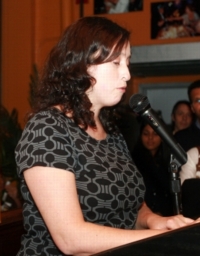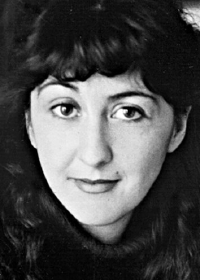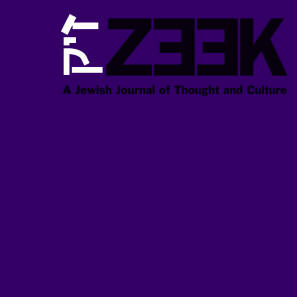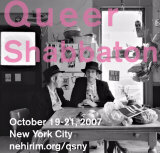 April 08
April 08
The Russification of Jewish-American Fiction
Andrew Furman
What would our Passover Seders have been like without our unfortunate brethren suffering under the Soviet yoke? “In every generation,” our Haggadahs insisted, “we must think and feel as if we had personally come out of Egypt.” But it was tough going to muster an affinity with those enslaved biblical Hebrews. Our powers of empathy couldn’t span epochs. While our parents cautioned us that anti-Semitism loomed around every corner, there seemed little evidence of the phenomenon in our sphere. We San Fernando Valley Jews had scrambled high enough up on the socioeconomic ladder that it was increasingly difficult to cling to our longstanding ethos of alienation, marginality, and general victimhood.
 |
|---|
Gary Shteyngart |
Unlike Elijah, that rube, who never came, the Russians actually showed up. Some short time after Gorbachev and glasnost, our Jewish brothers and sisters, freed from the Pharoah of Soviet communism, came to our open-armed shores. If they suddenly provided a somewhat less potent symbol of our collective persecution, they still had it pretty bad. Former engineers, doctors, and teachers were forced in America to accept lowly jobs as salespeople, store clerks, and teachers. Their children, at least those few immigrant children in my sphere, were mostly awkward, quiet, and wary. Who knew that they were just biding their time?
There’s an old joke attributed to Alfred Kazin that goes something like this: “What’s the difference between the International Ladies’ Garment Workers’ Union and the American Psychiatric Association?” The punch-line: “One generation.” Strikingly, indeed, the sons and daughters of a largely benighted generation of Russian immigrants have emerged over the last five years to occupy the center of our Jewish-American literary culture. Gary Shteyngart’s The Russian Debutante’s Handbook (2002), a lusty Russian bear of a novel, was the first shot across the bow of the American, and Jewish-American, literary scene. Its linguistic brio, its unfettered imaginative daring, its spot-on portraiture of giant, carnivalesque personalities, its uncontainable picaresque plot. . . . no one was surprised when the novel won the National Jewish Book Award in Fiction.
As the literary world was busy showering Shteyngart’s debut with accolades, other young Russian immigrant writers such as Lara Vapnyar and David Bezmozgis were putting the final touches on their first fiction manuscripts, There are Jews in My House (2003) and Natasha (2004), respectively. Through these story collections, Vapnyar and Bezmozgis evoke the jagged contours of Jewish life in the Soviet Union and the tumultuous transition westward through a more restrained, understated English prose, through nearly Carveresque artistic temperaments. Shteyngart and Vapnyar have since contributed follow-ups to their first efforts–the uproarious Absurdistan (2006) and the carefully observed Memoirs of a Muse (2006)–and books by new Russian Jewish fiction writers continue to emerge, most notably Anya Ulinich’s Petropolis (2007), set in various Russian and American locales, sprawling and picaresque in its reach, and Ellen Litman’s The Last Chicken in America (2007), set amid the Russian Jewish enclave of Squirrel Hill, Pittsburgh.
 |
|---|
Anya Ulinicht |
This cavalcade of Jewish artistic talent is something to celebrate. Publishing their fiction in the hippest lit mags (e.g., The New Yorker, Harper’s, Zoetrope, Tin House, TriQuarterly, and Zeek), winning a whole host of mainstream awards and honors, these writers have shepped us some serious naches. What to make of all this hoopla? What does it reflect (if anything) about the proclivities and preferences of American readers, their expectations of and demands upon the Jewish voice? What does all this bode for the future shape of Jewish-American fiction?
There’s an illustrative scene about midway through Shteyngart’s debut novel. His protagonist, Vladimir Girshkin, tangled up with the Russian mafia in an imaginary, post-Soviet city in Eastern Europe, comes across a thoroughly assimilated, Americanized Jew (from Iowa, no less) named Perry Cohen. An aspiring writer, Cohen shares with Girshkin the story of his rather prosaic childhood, “suffering” under the gentle thumb of his wealthy, self-hating father, who changes his name to Caldwell. “So that was his story!” our hero contemplates,
That was Cohen’s theme! His father was a rich asshole. How shocking. Vladimir was ready to attack Cohen with his own background, from the Jew-baiting of Leningrad to his years as a Stinky Russian Bear in Westchester. Assimilation, my ass. What do you know of assimilation, spoiled American pig? Why, I’ll show you . . . I’ll show you all!
There’s a good bit of narrative distance here. Shteyngart goes on to satirize his hero’s exploitation of his more exotic travails at the same time that he exposes the banality, the thinness, of Cohen’s story. All the same, this moment of competitiveness between Jewish writers, Girshkin’s one-upmanship, offers a neat analogue of the real life internecine anxiety amid our Russification of Jewish-American letters. For what is Shteyngart doing if not making a brazen power-grab? Girshkin, and by extension Shteyngart, is the true Jew at the millennium, while us born-here Jews, so the logic goes, are mere pretenders, having forfeited our Jewishness to become “spoiled American pig[s].” Well for crying out loud, Gary. Isn’t it bad enough that a Chinese-American writer, Gish Jen, has horned in on our territory, sending up a thinly veiled Jewish Scarsdale in her celebrated novel, Mona in the Promised Land (1996), bagels emblazoned all over the cover!? A Cynthia Ozick blurb, to boot!? Now, even our fellow Jews are dissin’ us, challenging the heft, the substance–in a word, the authenticity–of our Jewish voices?
And after all we did for the Russians!
A quick glance at the trajectory of Jewish-American fiction in the twentieth century will go some way toward explaining these sentiments. Jewish writers in America first gained traction on the literary scene by deploying their distinct, immigrant sensibility of marginality and alienation. The soul of modern Jewish-American fiction can be found along the gritty immigrant asphalt of Saul Bellow’s Napolean Street in Herzog (1964); in the Yiddish inflections and syntax of Bernard Malamud’s bakers and gesheft owners, haunted by the old world, beaten and battered by the new; and in Philip Roth’s younger generation, struggling (through their brains and their shlongs) to claim a larger portion of America in the leafy suburbs. These writers pretty much constituted our golden age in the 1950s and 1960s, and inspired renewed interest in largely forgotten earlier immigrant writers, such as Abraham Cahan, Mary Antin, Henry Roth, and Anzia Yezierska (although Women’s Studies programs can claim ample credit for her retrieval).
As that Ashkenazi immigrant experience faded from memory, however, Jewish American fiction ran into a bear market. Bellow and his cronies pretty much devoured their literary children. By the 1970s and 1980s, Jewish writing in America seemed less and less central, and inspired a few critics to dismiss the likelihood that a subsequent generation of distinctively Jewish writers would ever come along and write anything worth reading. Irving Howe, alluding specifically to our waning immigrant days (I won’t be the millionth writer to quote him), was probably the most infamous gloom and doomer in the 1970s, but Leslie Fiedler threw more dirt on the coffin, noting in a 1986 New York Times Book Review article (for all the goyim to read!) that “the Jewish American novel is over and done with, a part of history rather than a living literature.” Bastard!
Howe and Fiedler were cultural icons, our lit crit heroes, so their words stung. Aspiring writers tended to internalize this notion that the immigrant experience, and the immigrant experience alone, offered the requisite fuel for Jewish artistic expression in America. Consider, for example, Steve Stern’s reflections, uttered the same year as Fiedler’s dour pronouncement above, upon winning the Edward Lewis Wallant Prize in Jewish-American fiction. “Born too late,” Steve Stern agonized over his fitful, early years of false starts, “I’d been cheated out of what I had coming: oppression and persecution you say, wretched poverty and nightmares amok in broad daylight I grant you, but also a vitality beyond anything I’d known.” It took years for Jewish-American writers like Stern to escape the shadow of our immigrant forebears, years to follow Cynthia Ozick’s lead to write a post-immigrant Jewish literature on their own terms.
 |
|---|
Lara Vapnyar |
Now what do Shteyngart and his Ruskii pals come along and do in our new postmodern, post-immigrant millennium? They tap into that familiar wellspring of Jewish-American creativity. Blessed with the great good fortune of immigrant oppression, persecution, poverty and nightmares, they claim an artistic kinship to Bellow, Roth, and Malamud–that holy trinity–that the rest of us born-here Jews can’t quite claim. One foot still firmly planted in the old world, these new Jewish writers in America conjure rich evocations of post-Czarist Europe in many of their stories and novels, an exotic, new old world, so to speak, which mainstream readers and even born-here Jewish writers know exceedingly little about, given the secrecy and jingoistic propaganda that defined the Cold War era. In Vapnyar’s chilling title story to There Are Jews in My House, for example, she offers a thoroughly unsentimental portrait of a gentile woman’s equivocal sheltering of her Jewish friend and her daughter in Nazi-occupied Russia. Vapnyar flashes forward in other stories and in her new novel, Memoirs of a Muse, to offer vivid renderings of the stark, Cold War Moscow streets. Gazing out a crowded bus in the story, “Lydia’s Grove,” our young female protagonist takes in the “wilted trees, grayish-white school buildings, identical supermarkets with dirty windows, Party slogans written in dirty white letters on faded red boards, and nine-story gray apartment buildings–all of them were long, some stretched for miles.”
Shteyngart’s novels, taken together, betray both his ardor for America and his curious impatience with the American landscape, as he ships both protagonists to imaginary, post-communist Russian outposts for the bulk of their journeys. Ulinich’s tactile renderings of Asbestos 2–the bleak Siberian outpost of her protagonist’s childhood–comprise the strongest, most self-assured sections of Petropolis. During certain glimmering moments, Ulinich evokes the lay of Sasha Goldberg’s homeland with Joycean precision:
Not many streets in Asbestos 2 had names, and the few named streets merged effortlessly with unnamed paths and shortcuts. Although all the apartments in town had been privatized, the land still belonged to the People, and people cut corners, trudged through ravines, crossed landfills, and sneaked through bushes, endlessly optimizing their journeys. When people slept, their footprints, iced over or filled with liquid mud, shone in the moonlight. On clear nights silver threads connected the school to the liquor store, the liquor store to the asbestos pit, the pit to the morgue, and the morgue to the Conversation Point, drawing a predictable diagram of daily life in a place unsuitable for living.
Focusing their gaze westward, these writers breathe new life into those venerable twin-themes of the Jewish experience in America, intergenerational guilt and shame. Parents, embittered over their impoverished circumstances amid the new, inscrutable American environs. Children, resentful that they must navigate the hostile territory on behalf of their longsuffering elders, buckling under their outsized expectations. “You have excellent marks in every subject. Yet you’re not going to make it to the top of the class!” an immigrant mother berates her son in one of Vapnyar’s stories. “It’s better to be invisible,” Masha contemplates in Litman’s title story to The Last Chicken in America. Her father, otherwise, “will remember . . . that I don’t do enough around the house, that I haven’t heard from the schools yet. . . . that my English is good, that my English isn’t good enough, that he still has to worry about me and my future, and that without a job there’s not much he can do for me.”
The younger generation doesn’t always fulfill the expectations of their parents, and the results can be even more devastating when they do. For in clambering up the social ladder in the new world, the protagonists in many of these tales symbolically kill their elders. This realization in Bezmozgis’s “Tapka” provokes an existential dread and shame that recalls Delmore Schwartz’s classic story, “In Dreams Begin Responsibilities.” Mark Berman, our young protagonist in Bezmozgis’ tale, helps care for Rita and Misha Nahumovsky’s beloved Lhasa-apso, Tapka, quarantined for a month in Canada upon their emigration. Alone and older, “stupefied by the demands of language,” the Nahumovskys smother Tapka with affection. Near disaster strikes when Berman’s act of carelessness results in the dog’s near death, which requires a costly operation. Although our hero knows that the dog will live, he also recognizes that in a very real sense he’s dealt the canine, and by extension his older fellow immigrants, a fatal blow. “Look at Rita; look at Misha. You see, who are you kidding? You killed Tapka and you will never be forgiven.”











